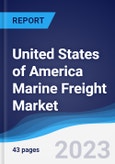Key Highlights
- The marine freight sector includes revenues generated from the transportation of containers (only LoLo) and dry bulk cargo by sea and ocean-going vessels. The sector encompasses domestic and international freight, which, for the purposes of this report, is counted in the country of origin.
- The US marine freight industry had total revenues of $206.5 billion in 2022, representing a compound annual growth rate (CAGR) of 5.6% between 2017 and 2022.
- The containerized segment accounted for the industry's largest proportion in 2022, with total revenues of $118.4 billion, equivalent to 57.3% of the industry's overall value.
- The US held a 21.9% stake in the global marine freight industry in 2022.
Scope
- Save time carrying out entry-level research by identifying the size, growth, major segments, and leading players in the marine freight market in the United States
- Use the Five Forces analysis to determine the competitive intensity and therefore attractiveness of the marine freight market in the United States
- Leading company profiles reveal details of key marine freight market players’ global operations and financial performance
- Add weight to presentations and pitches by understanding the future growth prospects of the United States marine freight market with five year forecasts
Reasons to Buy
- What was the size of the United States marine freight market by value in 2022?
- What will be the size of the United States marine freight market in 2027?
- What factors are affecting the strength of competition in the United States marine freight market?
- How has the market performed over the last five years?
- What are the main segments that make up the United States's marine freight market?
Table of Contents
Companies Mentioned (Partial List)
A selection of companies mentioned in this report includes, but is not limited to:
- Landstar System, Inc.
- A.P. Moller-Maersk A/S
- COSCO Shipping Holdings Co Ltd
- CMA CGM SA
- MSC Mediterranean Shipping Co SA








